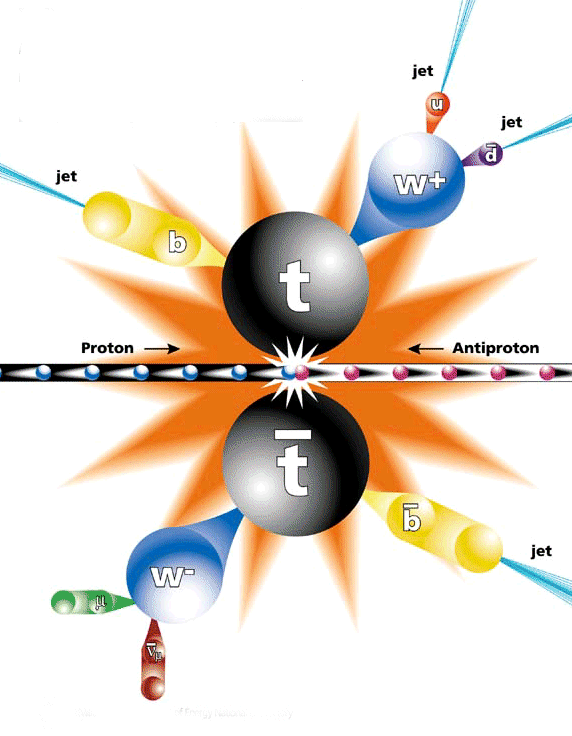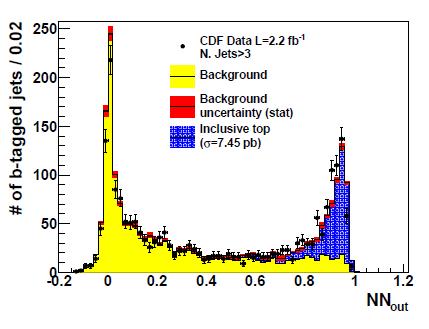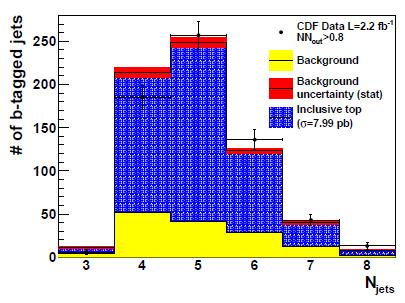A paper made public yesterday by the CDF collaboration reminds me of one very lucky new idea that I had, together with my then Ph.D. student Giorgio Cortiana, to collect a sample of top pair decays that nobody had yet thought of extracting. The resulting analysis, based on Giorgio's PhD thesis, as well as a few others which followed soon thereafter, was probably one of the most inventive contributions to CDF I can boast about, and represented a significant contribution to the measurement capabilities of CDF in the top quark sector.
To explain what this is about, let me try and be didactic -I have to remind myself I still can, from time to time, because this blog has lately shown the tendency to drift away from popularization of science to technical discussions, and that is something I need to dampen.
Quick Reminder on Top Quarks
 Top quark pairs may be produced at the Tevatron proton-antiproton collisions when a energetic quark and its antiparticle hit each other head on; this happens only if the total energy of the collision is larger than twice the mass of the top quark. Since the top is very massive (172 GeV or so), such collisions are very rare, with the result that only once in ten billion proton-antiproton collisions a top quark pair pops into existence.
Top quark pairs may be produced at the Tevatron proton-antiproton collisions when a energetic quark and its antiparticle hit each other head on; this happens only if the total energy of the collision is larger than twice the mass of the top quark. Since the top is very massive (172 GeV or so), such collisions are very rare, with the result that only once in ten billion proton-antiproton collisions a top quark pair pops into existence.Being very massive, the top quark is very eager to disintegrate. It does so at a fantastic speed, turning into a W boson and a b-quark. The b-quark produces a hadronic jet -a stream of collimated, energetic hadrons; the W boson decays into an electron-neutrino pair, or a muon-neutrino pair, or a tauon-neutrino pair, or a pair of quarks. Since quarks come in three colours and there are two possible quark pairs into which the W can decay (ud or cs, while quarks of the third family are prevented by the too large mass of the top), there are a total of six possible quark pair decays against only three leptonic decays, so the democratic W boson chooses to go one ninth of the time into each.
The final result of the top pair production and decay chain thus involves two b-jets (one from each bottom quark produced when each top emits a W), and either four additional hadronic jets (from two W->qq decays); or two jets and a lepton-neutrino pair; or two lepton-neutrino pairs. Physicists call these signatures "all-hadronic", "lepton plus jets", and "dileptonic", because the distinguishing feature is the presence of zero, one, or two charged leptons.
Note that the all-hadronic signature arises 6/9 * 6/9 = 44% of the time; also note that by "leptons" experimentalists oftentimes mean electrons or muons, since tau leptons are harder to identify with certainty. So the "single lepton" final state arises 2 * 6/9 * 2/9 of the time (the first factor of two is due to the fact that either the first or the second W can go into quarks), or 30%. The "dilepton" topology is just happening 2/9 * 2/9 of the time, or 5%.
The above classification has been a standard ever since top quarks were shown (in 1988) to have a mass larger than the W boson, such that the t->Wb decay was then practically the only one occurring with a significant rate. The first observation of top quarks in 1995 was produced in samples of single lepton and dilepton candidates: these are the ones with the best signal to background ratio. Then, in 1997 a difficult fight with the much higher background from strong interaction processes (which readily produce a six-jets final state at a rate that totally drown the tiny top signal) allowed my colleagues in Padova and I to first observe the all-hadronic decay of top quark pairs.
What was there left to study ? Of course, all the final states involving tau leptons were also pursued with momentum. This was the search for the "tau dileptonic" final state, the one where one sought for an electron or a muon together with a tau candidate. Taus are hard to identify because they often decay (in a very short time, which prevents the experimental detection of the tau track) into light hadrons, producing narrow jets that get mimicked by the much larger background from strong interaction processes.
What else ? No other channel, basically. Different techniques were developed to increase either the purity of signal selections, or their acceptance. The goal was to measure as precisely as possible, and with as many independent techniques as possible, the production rate and the mass of the top quark. But nobody came up with additional datasets where to look for top pairs. Except Giorgio and I.
The new idea
The idea we had was to use a sample of events with jets, thus dominated by strong interaction processes, to extract not any more the all-hadronic decay signal, but rather all the top quark pairs which had decayed in the lepton plus jets final state but where the lepton had been missed by the detector. The acceptance to electrons and muons of the CDF detector is not nearly 100%: CDF is equipped to measure them only if they are rather centrally produced, while if they are emitted at small angle from the beam they are unobservable.
The idea was than that if the lepton is overlooked or lost in a lepton plus jets topology, what is left is a jets plus neutrino final state.
A selection requiring jets and a significant amount of missing transverse energy had not tried before for top quark searches; it had, in truth, been considered for Supersymmetric searches, where the top production was a annoying background, indeed. Missing transverse energy arises every time a energetic neutrino leaves the detector unseen, but its measurement is complicated by the fact that in the presence of many jets the missing Et resolution is not very good.
What Giorgio and I realized, however, was that by requiring that the missing Et in the event was significant, we were enriching the sample with all single lepton top pair decays where the lepton had been lost, as well as with all top pair decays involving a tau lepton. In the meantime, the strict requirement on missing transverse energy kicked away most of the annoying background from strong interactions, because strong interactions rarely yield neutrinos (they do so only through the weak decay of hadrons).
The idea was turned into practice by employing a data-driven background estimate based on the prediction of the number of jets containing b-quark decay signals (b-tags). That technique was not new: we had pioneered it 6 years before for the all-hadronic top quark observation, again in Padova.
When the top cross section was measured from the sample of top decays that we had isolated, we obtained the third most precise estimate: an unbelievable success for a new analysis.
The New Result
Along the lines of our early measurement, a new result has been just released by CDF. Author is Gabriele Compostella, who worked with the Padova group, following the footsteps of Giorgio and I. But Gabriele improved strongly our data selection procedure, using a Neural Network classifier to distinguish between top pair events and backgrounds using detailed information on the event kinematics.
 The Neural Networks is capable of strongly discriminating the signal events, as is clear from the picture shown on the right. There, the data are shown on a histogram of the NN output. The top pair signal is shown by the blue histogram at high values of the output: a significant signal is observed.
The Neural Networks is capable of strongly discriminating the signal events, as is clear from the picture shown on the right. There, the data are shown on a histogram of the NN output. The top pair signal is shown by the blue histogram at high values of the output: a significant signal is observed.By selecting events with high values of the NN output, Gabriele and collaborators managed to isolate a sample of top quark pair decays with a signal to noise ratio which is almost unbelievably high for a selection based only on jets and missing energy: it rivals the standard selections based on well-identified electrons or muons in the standard "lepton plus jets" topologies.

In the end, the selected sample can be displayed in a histogram where the horizontal axis shows the number of jets of each event, and the height of the bar is the total number of b-tagged jets that are found, in events at high NN output values with the jet multiplicity corresponding to the x axis value. The resulting plot (on the left) is almost completely blue! Such a large sample of top quark decay candidates guarantees that the systematic uncertainty in the number of isolated top events is going to be small.
From the observed number of top events one can derive the cross section, by dividing the number by the detection efficiency (which simulations can predict) and by the total integrated luminosity of the dataset (which is measured with other techniques). The final measurement is 7.99+-1.05 picobarns, in good agreement with theoretical predictions. The error bar is competitive with the most accurate measurements of the top pair production cross section in CDF, as can be checked in the figure below, which summarizes the most recent and precise results (the present measurements is the second-to-last).

It only remains for me to congratulate with Gabriele for this very nice new result, which really pleases me. Jets plus met rocks!



Comments